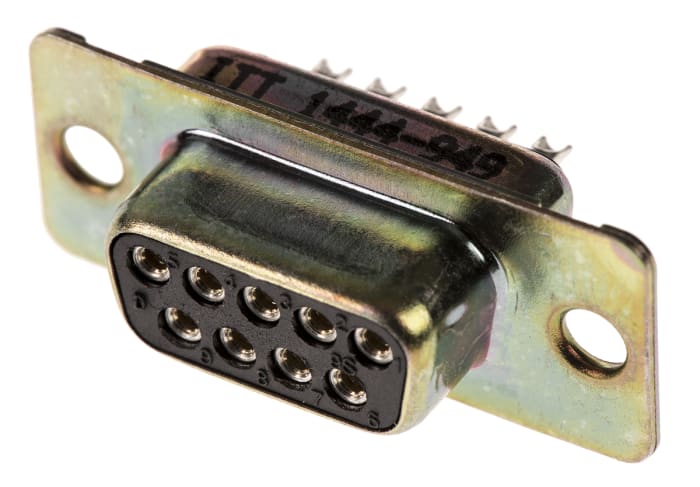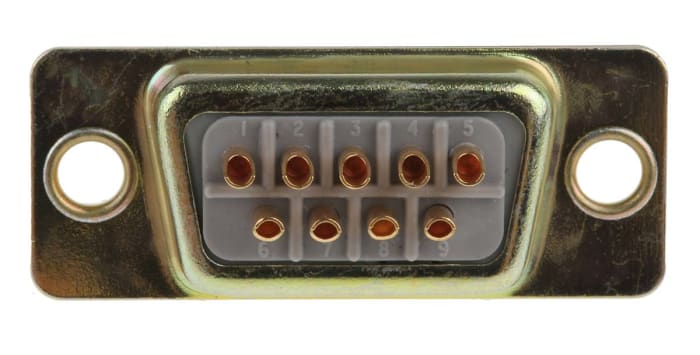RS PRO 9 Way Panel Mount D-sub Connector Socket, 2.74mm Pitch

Technical documents
Specifications
Brand
RS ProNumber Of Contacts
9
Gender
Female
Body Orientation
Straight
Mounting Type
Panel Mount
Pitch
2.74mm
D Connector Type
Standard D-Sub
Termination Method
Solder
D-Sub Shell Size
E
Current Rating
5.0A
Housing Material
Steel
Voltage Rating
750.0 V
Length
30.81mm
Width
10.92mm
Depth
12.55mm
Dimensions
30.81 x 10.92 x 12.55mm
Contact Plating
Gold over Nickel
Contact Material
Gold over Nickel
Minimum Operating Temperature
-65.0°C
Maximum Operating Temperature
+125°C
Country of Origin
United Kingdom
Product details
RS PRO High Reliability D-Sub Connector with Solder Cups
From RS PRO a durable, highly reliable D-Subminiature connector designed for use in environments where high reliability is key. This connector has a steel shell and a diallyl phthalate insulator. Diallyl phthalate is a type of plastic which has good electrical properties, high heat resistance, good dimensional stability and high strength. The qualities of this material enhance the electrical performance of the connector. This connector is a commercial version of M24308 military connectors.
What is a D-Sub Connector?
A D-Sub connector is a popular type of I/O (input/output) connecter that is commonly used in the computer and datacoms industry to provide power and point-to-point communications between two devices such as a computer and a monitor. The d-sub contains two or more parallel rows of pins or sockets surrounded by a D-shaped metal shell which provides mechanical support and ensures the correct orientation is used when mating. These d-subs are available as female D-sub sockets (or d-sub receptacles) with female contacts or male D-sub plugs with male pin contacts. The socket style female connector mates with the plug style male connector. Please note that a D-sub with a plastic shell cannot be mated with a D-sub with a metal shell.
Features and Benefits
• Highly reliability and high performance
• Zinc plated steel shell with yellow chromate finish
• Gold plated pin machined contacts for precision performance
• Monoblock green diallyl phthalate insulator for improved electrical performance
• Flanges for screw mounting to a panel
• Solder cups for simple wire termination
Applications
This highly reliable d-sub connector with its robust design and high reliability can be used in communications and network ports in a wide range of industries including industrial, commercial and medical. Applications include the following:
• Computers, monitors and scanners
• Networking and communications equipment
• Data processing equipment
• Industrial and medical equipment
• Test and measurement instrumentation
• Remote sensors and dataloggers
• Portable electric generation equipment
Frequently Asked Questions
How do you terminate the wires into the connector?
These d-subs feature solder cups which are hollow cup-like cavities into which the wire is inserted and secured by soldering. Firstly make sure the connector is held securely while working on it. Strip the ends of each wire using the depth of solder cups to gauge how much insulation you need to remove. Tin the exposed wire strands with a soldering iron and partially fill the solder cup with solder. Apply a soldering iron to the edge of the cup allowing the solder to melt. Insert the end of the tinned wire into the cup and hold it in place until the solder becomes solid. If the wire gauge is large enough to support itself in the cup place it in the cup and feed in the solder whilst applying the soldering iron to the back of the cup.
How do you mount these connectors?
These d-subs are designed to be panel mounted. A hole is cut in the panel which is determined by the panel cut-out dimensions of the plug or socket. Two mounting flanges either side of the connector incorporate mounting holes. Holes are drilled into the panel to align with these mounting holes. The connector is then inserted into the panel cut-out and secured in place by inserting screws through the holes in both the connector and panel.
High Specification & Aerospace & Industrial Connectors
P.O.A.
1
P.O.A.
1
Stock information temporarily unavailable.
Please check again later.
| quantity | Unit price |
|---|---|
| 1 - 24 | P.O.A. |
| 25 - 99 | P.O.A. |
| 100 - 499 | P.O.A. |
| 500 - 999 | P.O.A. |
| 1000+ | P.O.A. |
Technical documents
Specifications
Brand
RS ProNumber Of Contacts
9
Gender
Female
Body Orientation
Straight
Mounting Type
Panel Mount
Pitch
2.74mm
D Connector Type
Standard D-Sub
Termination Method
Solder
D-Sub Shell Size
E
Current Rating
5.0A
Housing Material
Steel
Voltage Rating
750.0 V
Length
30.81mm
Width
10.92mm
Depth
12.55mm
Dimensions
30.81 x 10.92 x 12.55mm
Contact Plating
Gold over Nickel
Contact Material
Gold over Nickel
Minimum Operating Temperature
-65.0°C
Maximum Operating Temperature
+125°C
Country of Origin
United Kingdom
Product details
RS PRO High Reliability D-Sub Connector with Solder Cups
From RS PRO a durable, highly reliable D-Subminiature connector designed for use in environments where high reliability is key. This connector has a steel shell and a diallyl phthalate insulator. Diallyl phthalate is a type of plastic which has good electrical properties, high heat resistance, good dimensional stability and high strength. The qualities of this material enhance the electrical performance of the connector. This connector is a commercial version of M24308 military connectors.
What is a D-Sub Connector?
A D-Sub connector is a popular type of I/O (input/output) connecter that is commonly used in the computer and datacoms industry to provide power and point-to-point communications between two devices such as a computer and a monitor. The d-sub contains two or more parallel rows of pins or sockets surrounded by a D-shaped metal shell which provides mechanical support and ensures the correct orientation is used when mating. These d-subs are available as female D-sub sockets (or d-sub receptacles) with female contacts or male D-sub plugs with male pin contacts. The socket style female connector mates with the plug style male connector. Please note that a D-sub with a plastic shell cannot be mated with a D-sub with a metal shell.
Features and Benefits
• Highly reliability and high performance
• Zinc plated steel shell with yellow chromate finish
• Gold plated pin machined contacts for precision performance
• Monoblock green diallyl phthalate insulator for improved electrical performance
• Flanges for screw mounting to a panel
• Solder cups for simple wire termination
Applications
This highly reliable d-sub connector with its robust design and high reliability can be used in communications and network ports in a wide range of industries including industrial, commercial and medical. Applications include the following:
• Computers, monitors and scanners
• Networking and communications equipment
• Data processing equipment
• Industrial and medical equipment
• Test and measurement instrumentation
• Remote sensors and dataloggers
• Portable electric generation equipment
Frequently Asked Questions
How do you terminate the wires into the connector?
These d-subs feature solder cups which are hollow cup-like cavities into which the wire is inserted and secured by soldering. Firstly make sure the connector is held securely while working on it. Strip the ends of each wire using the depth of solder cups to gauge how much insulation you need to remove. Tin the exposed wire strands with a soldering iron and partially fill the solder cup with solder. Apply a soldering iron to the edge of the cup allowing the solder to melt. Insert the end of the tinned wire into the cup and hold it in place until the solder becomes solid. If the wire gauge is large enough to support itself in the cup place it in the cup and feed in the solder whilst applying the soldering iron to the back of the cup.
How do you mount these connectors?
These d-subs are designed to be panel mounted. A hole is cut in the panel which is determined by the panel cut-out dimensions of the plug or socket. Two mounting flanges either side of the connector incorporate mounting holes. Holes are drilled into the panel to align with these mounting holes. The connector is then inserted into the panel cut-out and secured in place by inserting screws through the holes in both the connector and panel.

